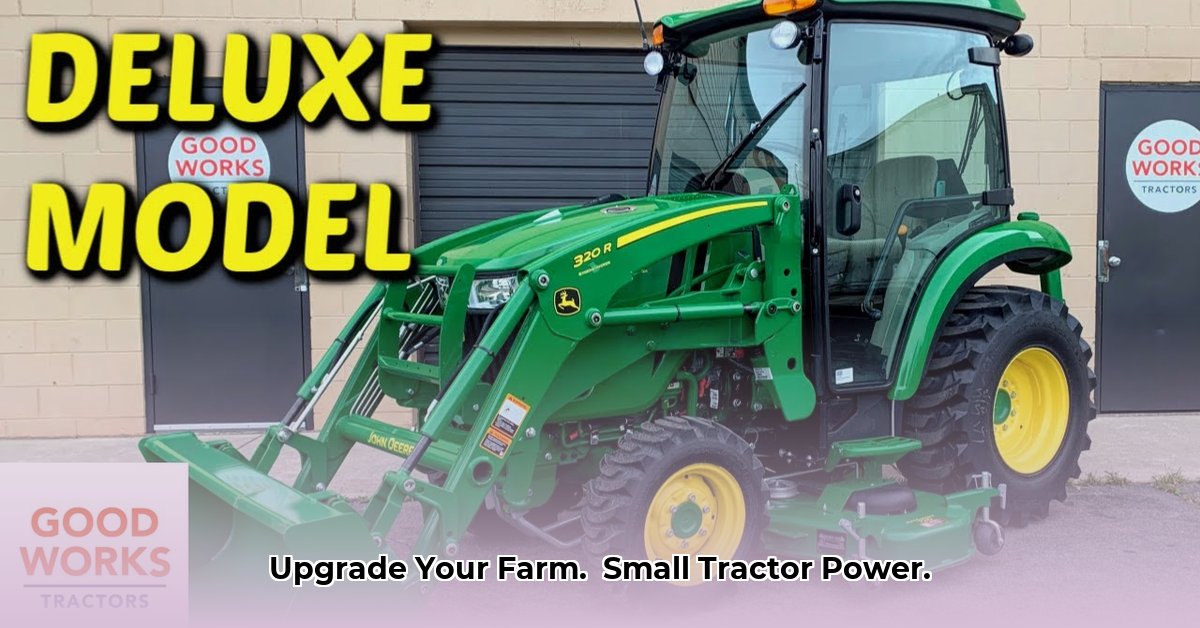
Finding the right small cab tractor can seem daunting, but this guide simplifies the process. We'll walk you through key considerations – from horsepower and features to budget and maintenance – helping you choose a tractor that perfectly fits your needs and budget. For more options, check out these small tractor options.
Power Play: Choosing the Right Horsepower
The tractor's horsepower directly impacts its capabilities. What tasks will dominate your workload? Small gardens or a few acres of pasture require less horsepower than large-scale operations involving plowing or hauling. Overestimating your needs leads to unnecessary expenses; underestimating leads to frustration. Match the horsepower to the scale of your operations and the intensity of the tasks – a small, fuel-efficient engine is ideal for light work, while demanding jobs require more power.
Essential Features: Beyond the Horsepower
Horsepower is crucial, but several features dramatically affect usability and longevity.
Four-Wheel Drive (4WD): Essential for uneven terrain, 4WD offers greatly enhanced traction, vital on hills, in mud, or wet conditions. For small farms, 4WD is strongly recommended for overall reliability.
Transmission Type: Hydrostatic transmissions provide smooth, infinitely variable speeds, ideal for beginners, while gear transmissions offer durability and precise control at higher speeds, better for experienced operators. The best option depends on your experience level and tasks.
Climate-Controlled Cab: A comfort feature increasing cost but improving working conditions, especially in harsh weather. Weigh its value against your climate and work habits; improved comfort can lead to extended working seasons.
Quick-Hitch Attachments: This time-saving feature allows for rapid switching between implements (mowers, tillers, plows), maximizing efficiency.
Implementing Compatibility: Ensuring Seamless Operation
Your tractor’s effectiveness hinges on implement compatibility. Before purchasing, list all intended tasks and verify compatibility with your chosen tractor model. A tractor incompatible with essential tools renders it less efficient and represents a costly error.
Budgeting Wisely: Planning Your Investment
Small cab tractors vary widely in price. Total cost includes the purchase price, implements, maintenance, fuel, and potentially insurance. Explore financing (loans, leases) and any available government subsidies for agricultural equipment. Remember, this is a long-term investment requiring careful financial planning.
Your Step-by-Step Tractor-Selection Journey
Follow these steps to find the ideal tractor:
Needs Assessment: Detail all tasks (tilling, mowing, hauling), acreage, and typical soil conditions. Be precise and realistic.
Budget Setting: Determine your maximum budget, including financing and potential additional costs.
Research and Comparisons: Research reputable brands (John Deere, Kubota, etc.), comparing horsepower, features, and prices. Online reviews and independent sources provide valuable insight. Note that Yanmar, while reputable, may have specific limitations depending on your needs and available attachments.
Test Driving: Test-driving different models allows you to experience their handling, ease of use, and overall feel, providing invaluable insight before making a commitment.
Specification Scrutiny: Meticulously compare specifications (power, transmission, hydraulics, implement compatibility) of your top choices.
The Final Decision: Select the tractor optimally balancing your needs, budget, and preferences.
Maintenance and Safety: Ensuring Long-Term Performance
Regular maintenance is crucial for a tractor’s longevity. This includes oil changes, filter replacements, and scheduled inspections. Consult the owner's manual for the manufacturer's recommended maintenance schedule. Adhering to safety regulations while operating the tractor is paramount for personal safety and the safety of others. Consider safety features as an investment in responsible farm management.
Have you considered the long-term maintenance costs associated with different tractor models? A factor often overlooked in the initial purchase decision.
Weighing the Pros and Cons
| Feature | Pros | Cons |
|---|---|---|
| Size & Maneuverability | Excellent maneuverability in tight spaces; easier operation and storage. | Lower lifting capacity compared to larger tractors. |
| Price | Typically lower initial cost than larger tractors. | May have fewer advanced features than larger models. |
| Fuel Efficiency | Generally more fuel-efficient than larger models. | Power limitations for extremely heavy tasks. |
| Maintenance | Usually less complex and less expensive to maintain. | Requires diligent preventative maintenance and scheduled servicing. |
Choosing a small cab tractor is a substantial investment. This guide provides a framework for informed decision-making, enabling you to select the perfect machine that optimizes your farm's sustainability and efficiency for years to come.